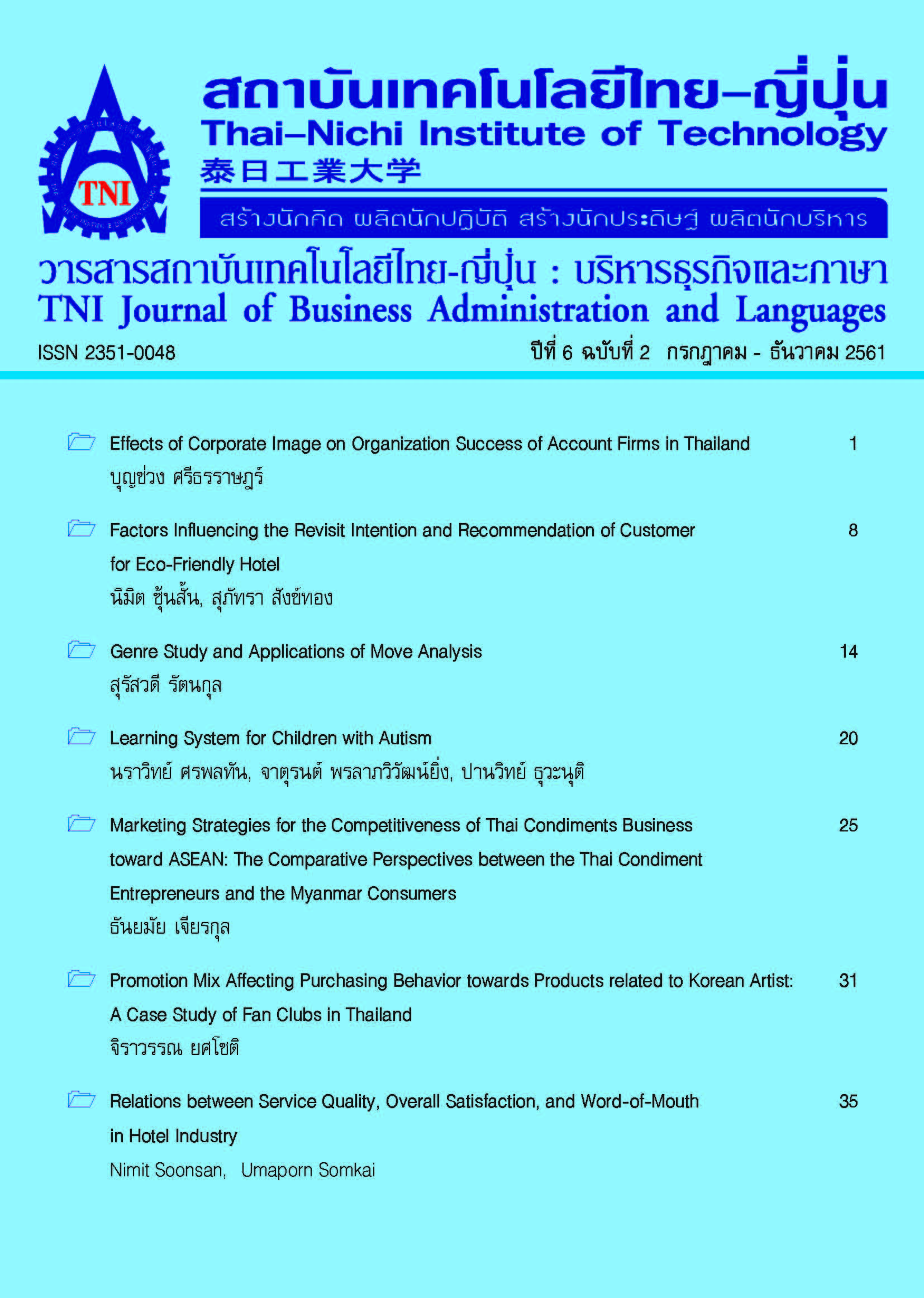Marketing Strategies for the Competitiveness of Thai Condiments Business toward ASEAN: The Comparative Perspectives between the Thai Condiment Entrepreneurs and the Myanmar Consumers
Main Article Content
Abstract
The research focused on (1) studying the marketing strategies affecting the decision to purchase Thai condiments (2) comparing the opinions to marketing strategies of Thai condiment between Thai condiment entrepreneurs and Thai condiment consumers in Myanmar, and (3) studying guidelines for development of Thai condiment entrepreneurs’ marketing strategies towards Myanmar. Research methodologies used were mainly in-depth interview and analysis on secondary data collected from eleven condiment entrepreneurs in Thailand and quantitative research was used by collecting 369 questionnaires from Myanmar consumers by using accidental sampling. The research results from Thai entrepreneurs found that innovations were encouraged. Original taste and distinctive traditional Thai characteristics were preferable. However, packaging should be modified into modern designs. Pricing of Thai condiment products should be aligned with quality. Furthermore, entrepreneurs should pay attention to suitable distribution channels and diverse marketing communication strategies through trade fairs and exhibitions, advertising, sales promotion and social media. From the consumers’ side, the research found that most of them have a positive attitude toward the Thai product. Fish sauce is the most popular condiment of Burmese. They always buy the Thai condiments from convenience stores. The most popular Thai food that they were cooking is Tom-yam. The most important factor that impact on their purchasing decision was price. The hypothesis testing found that the three factors of marketing strategies included price, place and promotion were correlated to purchasing decision process at a significant level of 0.05. The guidelines of exporting the Thai condiments to Myanmar were discussed.
Article Details
Article Accepting Policy
The editorial board of Thai-Nichi Institute of Technology is pleased to receive articles from lecturers and experts in the fields of business administration, languages, engineering and technology written in Thai or English. The academic work submitted for publication must not be published in any other publication before and must not be under consideration of other journal submissions. Therefore, those interested in participating in the dissemination of work and knowledge can submit their article to the editorial board for further submission to the screening committee to consider publishing in the journal. The articles that can be published include solely research articles. Interested persons can prepare their articles by reviewing recommendations for article authors.
Copyright infringement is solely the responsibility of the author(s) of the article. Articles that have been published must be screened and reviewed for quality from qualified experts approved by the editorial board.
The text that appears within each article published in this research journal is a personal opinion of each author, nothing related to Thai-Nichi Institute of Technology, and other faculty members in the institution in any way. Responsibilities and accuracy for the content of each article are owned by each author. If there is any mistake, each author will be responsible for his/her own article(s).
The editorial board reserves the right not to bring any content, views or comments of articles in the Journal of Thai-Nichi Institute of Technology to publish before receiving permission from the authorized author(s) in writing. The published work is the copyright of the Journal of Thai-Nichi Institute of Technology.
References
[2] “เครื่องปรุงรสอาหาร : รุกขยายตลาดช่วงเทศกาลกินเจ,” positioning. [ออนไลน์]. แหล่งที่มา: https://positioningmag.com/31277. [เข้าถึงเมื่อ: 20-เม.ย.-2556].
[3] “ลุ้นส่งออกอาหารปี56 ทะลุเป้า1ล้านล้านบาท,” thairath. [ออนไลน์]. แหล่งที่มา: https://www.thairath.co.th/content/327910. [เข้าถึงเมื่อ: 20-เม.ย.-2556].
[4] ธันยมัย เจียรกุล, ณัฐพล พนมเลิศมงคล และสุทธินันทน์ พรหมสุวรรณ, “ศักยภาพของผู้ประกอบการธุรกิจเครื่องปรุงรสไทย เพื่อเข้าสู่ตลาดการแข่งขันในประชาคมเศรษฐกิจอาเซียน,” วารสารธุรกิจปริทัศน์, ปีที่. 6, ฉบับที่. 2, หน้า. 55–74, 2557.
[5] ธันยมัย เจียรกุล, รายงานวิจัย กลยุทธ์ทางการตลาดที่มีผลต่อกระบวนการ ตัดสินใจซื้อเครื่องปรุงรสไทยของชาวเมียนมาร์ที่อาศัยอยู่ในประเทศไทย กรุงเทพฯ: สถาบันเทคโนโลยีไทย-ญี่ปุ่น. 2559
[6] บริษัทผลิตและจำหน่ายน้ำพริกสำเร็จรูปขนาดใหญ่, “ผู้บริหารบริษัทผลิตและจำหน่ายน้ำพริกสำเร็จรูปขนาดใหญ่,” 20-ม.ค.-2557.
[7] บริษัทผลิตและจำหน่ายน้ำตาลขนาดใหญ่, “ผู้บริหารบริษัทผลิตและจำหน่ายน้ำตาลขนาดใหญ่,” 26-ก.พ.-2557.
[8] บริษัทผลิตและจำหน่ายกะทิสำเร็จรูป, “ผู้บริหารบริษัทผลิตและจำหน่ายกะทิสำเร็จรูป,” 12-ธ.ค.-2556.
[9] บริษัทผลิตและจำหน่ายซีอิ๊วขาวขนาดใหญ่, “ผู้บริหารบริษัทผลิตและจำหน่ายซีอิ๊วขาวขนาดใหญ่,” 20-ธ.ค.-2556.
[10] โรงงานผลิตน้ำพริกของผู้ประกอบการ, “ผู้ประกอบการผลิตและจำหน่ายน้ำพริกสำเร็จรูปขนาดย่อย,” 6-ม.ค.-2557.
[11] บริษัทผลิตและจำหน่ายผงปรุงรส, “บริษัทผลิตและจำหน่ายผงปรุงรส,” 10-ม.ค.-2557.


